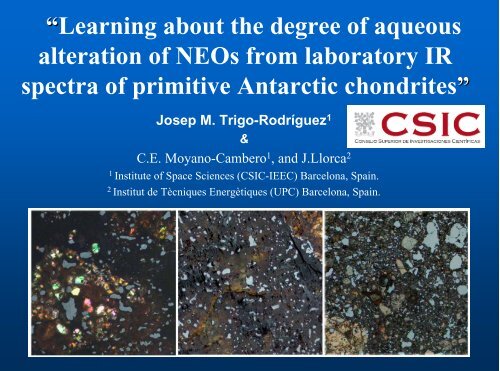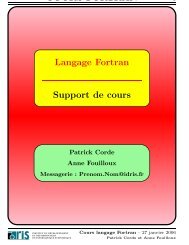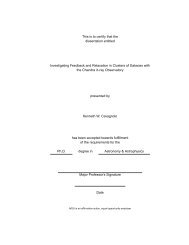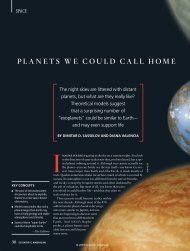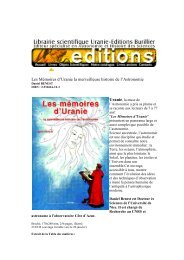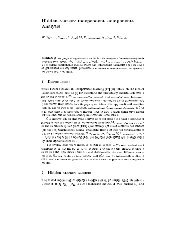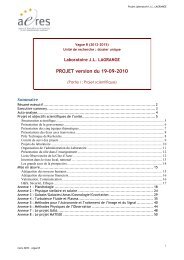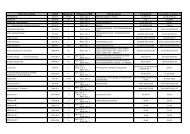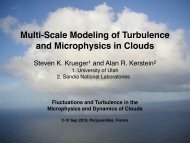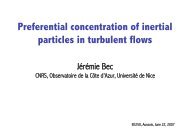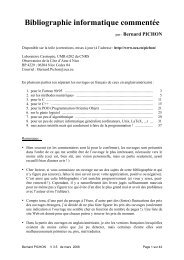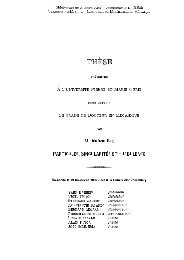ââLearning about the degree of aqueous alteration of NEOs from ...
ââLearning about the degree of aqueous alteration of NEOs from ...
ââLearning about the degree of aqueous alteration of NEOs from ...
You also want an ePaper? Increase the reach of your titles
YUMPU automatically turns print PDFs into web optimized ePapers that Google loves.
“Learning <strong>about</strong> <strong>the</strong> <strong>degree</strong> <strong>of</strong> <strong>aqueous</strong><br />
<strong>alteration</strong> <strong>of</strong> <strong>NEOs</strong> <strong>from</strong> laboratory IR<br />
spectra <strong>of</strong> primitive Antarctic chondrites”<br />
Josep M. Trigo-Rodríguez 1<br />
&<br />
C.E. Moyano-Cambero 1 , and J.Llorca 2<br />
1<br />
Institute <strong>of</strong> Space Sciences (CSIC-IEEC) Barcelona, Spain.<br />
2 Institut de Tècniques Energètiques (UPC) Barcelona, Spain.
OUTLINE<br />
• How biased is <strong>the</strong> available sample <strong>of</strong> Carb. Chond. (CCs)?<br />
• We have studied a significant sample <strong>of</strong> historic falls<br />
• The NASA Antarctic collection opportunity: rare groups<br />
• Chondrites groups and reflectance properties in IR<br />
• Main bands and features in IR spectra <strong>of</strong> CCs<br />
– Recent findings on CM, CR, CI and CV groups.<br />
– ATR spectroscopy results <strong>from</strong> 2 to 40 m<br />
• Intrinsic chemical differences in chondrites<br />
– Collisional effects: compaction, brecciation and <strong>aqueous</strong> <strong>alteration</strong><br />
• Implications for sample recovery in Marco-Polo-R<br />
• Preliminary results<br />
• Conclusions
WHAT WE KNOW ABOUT CARBON-RICH<br />
RICH<br />
ASTEROIDS FROM THEIR METEORITES?<br />
253 Mathilde, NEAR Shoemaker (NASA)<br />
• Chondritic meteorites are coming <strong>from</strong><br />
undifferentiated bodies<br />
• 15 chondrite groups identified so far<br />
(Weisber et al., 2006)<br />
– Then our overall view is highly biased!<br />
Hiroi et al. (2001)<br />
• Chemical differences among <strong>the</strong><br />
chondrite groups suggest that each<br />
group represents rocks <strong>from</strong> a different<br />
reservoir (see e.g. Scott, 2007)<br />
• This idea has been reinforced because<br />
few chondrite breccias exist containing<br />
clasts <strong>from</strong> different chondrite groups<br />
(Bisch<strong>of</strong>f et al, 2006)<br />
• Primitive asteroidal surfaces are not<br />
only brecciated, but also covered by<br />
rubble (not so important for small ones)
CHONDRITE GROUPS<br />
Weisberg et al. (2006)<br />
• Different <strong>degree</strong>s <strong>of</strong> <strong>aqueous</strong> <strong>alteration</strong><br />
and metamorphism are found<br />
• The CCs can be classified according <strong>the</strong><br />
estimated T required to produce <strong>the</strong><br />
petrographic types (Dotto et al., 2005)<br />
• The highest hydrated groups<br />
correspond to <strong>the</strong> carbonaceous<br />
chondrites, particularly: CMs, CRs,<br />
and CIs<br />
• At <strong>the</strong> Institute <strong>of</strong> Space Sciences<br />
(CSIC-IEEC) we work in <strong>the</strong> lab<br />
focusing on <strong>the</strong> role <strong>of</strong> <strong>aqueous</strong><br />
<strong>alteration</strong> on primitive chondrites and<br />
performing remote studies <strong>of</strong> comets<br />
• Particularly, <strong>the</strong> reflectance spectra are<br />
taken in <strong>the</strong> UPC Center for Research in<br />
NanoEngineering<br />
Dotto et al. (2005)
IR SPECTROMETER<br />
IR BEAM SAMPLE<br />
haz IR<br />
Muestra<br />
P<br />
• Small chips <strong>of</strong> each meteorite were grinded using an agate mortar<br />
• Powders were carefully located in between a diamond detector <strong>of</strong> a<br />
Smart Orbit ATR (Attenuated Total Reflectance) IR spectrometer.<br />
• This instrument provides high resolution internal reflection spectra<br />
<strong>of</strong> meteorite powders following standard procedures and using a<br />
diamond detector
NASA ANTARCTIC CHONDRITES<br />
Y791198 CM2<br />
QUE93005 CM2<br />
Meteorite Group Weatering grade Year<br />
ALH 77003 CO3.6 Ae 1977<br />
ALH 83108 CO3.5 A 1983<br />
ALH 84028 CV3 Ae 1984<br />
EET 92159 CR2 B/C 1992<br />
GRA 95229 CR2 A 1995<br />
LAP 02342 CR2 A/B 2002<br />
MAC 02606 CM2 A 2002<br />
MET 01070 CM1 Be 2001<br />
MET 01074 CV3 B 2001<br />
MIL 07689 CM1 C 2007<br />
PRE 95404 R3 A 1995<br />
QUE 97990 CM2 Be 1997<br />
QUE 99038 CM2 A/B 1999<br />
QUE 99355 CM2 B 1999<br />
SCO 06043 CM1 ~B 2006
ADDITIONAL STUDIED CHONDRITES<br />
• Selection <strong>of</strong> historic carbonaceous chondrites, mostly well-preserved<br />
falls, that are also included in our IR study<br />
Meteorite Group Fall/Find Year<br />
Allende CV3 Fall 1969<br />
Cold Bokkeveld CM2 Fall 1838<br />
Kainsaz CO3.2 Fall 1937<br />
Leoville CV3 Find 1961<br />
Mokoia CV3 Fall 1908<br />
Murchison CM2 Fall 1969<br />
Murray CM2 Fall 1950<br />
Orgueil CI 1 Fall 1864
SPECTRA OF CI and CM CHONDRITES<br />
• For <strong>the</strong> CMs several absorption bands exhibit different depths in agreement with<br />
previous studies using IR micro-spectroscopy [e.g. Beck et al. (2010), GCA 74]<br />
• The variable depth in OH bands at ~3 m exhibited by some <strong>of</strong> <strong>the</strong> selected CMs is<br />
probably consequence <strong>of</strong> different <strong>degree</strong>s <strong>of</strong> <strong>aqueous</strong> <strong>alteration</strong><br />
Trigo-Rodríguez et al. (2012) LPSC abstract #1443
MAIN ABSORPTION BANDS<br />
• The absorption bands identified so far are mostly due to clay minerals,<br />
and organic features:<br />
– Clay minerals in chondrites exhibit distinctive absorption peaks than those<br />
shown in terrestrial clays as also was found by Beck et al. (2010)<br />
Mineral (cm-1) (m) Notes<br />
OH stretching hydroxyl groups 3450 2.9 Mostly all groups<br />
(Montmorillonite,<br />
smectite, etc...)<br />
CC double bond stretch 1650 6.1 Organics, CMs<br />
CH 2 & CH 3 bend bands 1450 & 1400 6.9 & 7.1 Organics, CMs<br />
N-C libration band 1064 9.4 CO, CV<br />
Al/Si-OH libration bands 930-950 10.8-10.5 Variable location<br />
Al-O and Si-O, out <strong>of</strong> plane ~610 16.4 Variable location, CMs
THE KEY BANDS IN THE mid-IR<br />
• The 3 m absorption band associated with OH hydroxyl groups is evident<br />
for CM chondrites, but in different <strong>degree</strong>s:<br />
– The depth <strong>of</strong> <strong>the</strong> OH bands seems to be directly related with <strong>the</strong> extent <strong>of</strong> <strong>aqueous</strong> <strong>alteration</strong>
CO and CV CHONDRITE GROUPS<br />
• The absorption bands are also present, but in distinguishable location as<br />
consequence <strong>of</strong> different mineralogy<br />
• IR spectra <strong>of</strong> CO, and CV carbonaceous chondrites analyzed so far. Kainsaz,<br />
ALH83108, and ALHA77003 are CO3 chondrites.<br />
• Over 30 m <strong>the</strong> results should be taken with caution<br />
Trigo-Rodriguez et al. (2012)
PRELIMINARY RESULTS<br />
• Significant differences in <strong>the</strong> reflectance spectra <strong>of</strong> CCs reflects a<br />
remarkable compositional diversity<br />
– The ATR technique is very sensitive to OH and o<strong>the</strong>r bonds absorption bands, but<br />
also provides information <strong>about</strong> organic features<br />
• CC groups exhibit components with distinctive abundance ratios<br />
– Chondrules are <strong>the</strong> abundant ingredients, but <strong>the</strong>y vary in average size and<br />
proportions, such as <strong>the</strong> Ca-Al rich inclusions (CAIs) and o<strong>the</strong>r components<br />
– Metal grain abundances are highly variable <strong>from</strong> being almost absent to ubiquitous<br />
depending <strong>of</strong> <strong>the</strong> chondrite group, and <strong>the</strong>ir presence inside <strong>the</strong> chondrules or in <strong>the</strong><br />
matrix has direct implications to reflectance<br />
• Laboratory analyses <strong>of</strong> <strong>the</strong> reflectance <strong>of</strong> Antarctic CCs provide useful<br />
information for remote characterization <strong>of</strong> Marco Polo-R target<br />
– An accurate IR spectrum provides very significant features and<br />
absorption bands that have direct application:<br />
• The depth <strong>of</strong> <strong>the</strong> OH bands are directly related with <strong>the</strong> extent <strong>of</strong> <strong>aqueous</strong> <strong>alteration</strong>:<br />
how much water is bounded in phyllosilicates<br />
• The distinctive features allow to make reasonable distinction <strong>of</strong> <strong>the</strong> different surface<br />
mineralogy (if it is a complex breccia)<br />
• Consequently, IR spectroscopy <strong>of</strong> <strong>the</strong> target in a small scale is essential for sampling<br />
pristine carbonaceous materials (Marco Polo-R goal)
CONCLUSIONS<br />
• Laboratory analyses <strong>of</strong> <strong>the</strong> reflectance <strong>of</strong> Antarctic CCs provide useful<br />
information for remote characterization <strong>of</strong> <strong>the</strong> presumably complex<br />
surface <strong>of</strong> Marco Polo-R and Osiris-Rex missions<br />
– IR spectra provide very significant features and absorption bands that have<br />
direct application:<br />
• The depth <strong>of</strong> <strong>the</strong> OH bands are directly related with <strong>the</strong> extent <strong>of</strong> <strong>aqueous</strong> <strong>alteration</strong>: how much<br />
water is bounded in phyllosilicates<br />
• The distinctive features allow to make reasonable distinction <strong>of</strong> <strong>the</strong> different surface<br />
mineralogy (if it is a complex breccia)<br />
• Consequently, IR spectroscopy <strong>of</strong> <strong>the</strong> target in a small scale is essential for sampling pristine<br />
carbonaceous materials (Marco Polo-R goal)<br />
– Carbon-rich asteroids are sources <strong>of</strong> all biogenic elements and have minerals<br />
that probably syn<strong>the</strong>sized complex organics (Martins, 2011):<br />
• Some features <strong>of</strong> <strong>the</strong> most abundant organics are also identifiable by using high-res IR spectra<br />
• We thank NASA Meteorite Working group and JSC curators for<br />
providing us with <strong>the</strong> samples to complete <strong>the</strong>se analyses.
• Marco Polo-R<br />
Symposium:<br />
• A symposium focusing on <strong>the</strong><br />
revolutionary information that<br />
future sample return missions<br />
can provide:<br />
– Particularly on <strong>the</strong><br />
cosmochemical and<br />
astrobiological issues, but<br />
open to all scientific issues<br />
concerning sample return<br />
challenges<br />
– Special poster session<br />
• You are all invited to attend!<br />
– Limited space<br />
– Note that <strong>the</strong> workshop is<br />
scheduled for:<br />
• 16-17 Jan. 2013<br />
• In <strong>the</strong> historical cloister <strong>of</strong><br />
<strong>the</strong> Institute for Catalan<br />
studies (IEC)<br />
• Near <strong>the</strong> famous Ramblas


